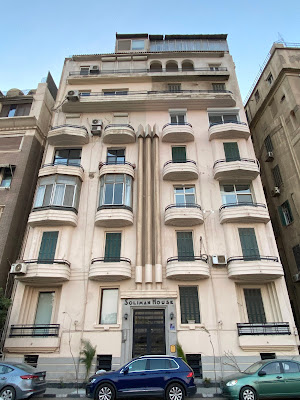Egyptian Experience - Day One
My Egyptian sojourn began at dawn as the
Egypt Air flight from Mumbai landed in Cairo. The temperature was a chilly 9
degrees. Immigration was a breeze. 23 others were partaking of my adventure. A
tall gilded statue of Serket – the ancient Egyptian goddess of protection –
welcomed us with open arms in the baggage hall. Our guide, a qualified
Egyptologist was waiting to receive us.
20 minutes later, we sat down to a traditional
Egyptian breakfast of Ful Medames (stew of fava beans), Ta’ameya (Egyptian
Falafel), fried aubergine slices, potato fingers, and hummus. These are staples
of Egyptian cuisine.
Indo-Egypt
Bonds
90 minutes later, we sat down on the steps
of Baron Empain Palace and were treated to a scintillating presentation on the
Indo-Egyptian connections by Bharat Gothoskar, the founder of Khaki Tours who
had carefully curated our experience. Trading ties between India and Egypt hark
back to the Ptolemaic and Roman periods. One of the most significant cultural
connections between India and Egypt is the Dawoodi Bohra community’s spiritual
ties to Cairo. This connection originates from the 11th century, when the Fatimid
Caliphate sent missionaries to Gujarat, where the Bohra community flourished.
Many Bohris visit the shrine in Cairo and also contribute towards renovation
and restoration projects. Our flights to and from Cairo had dozens of Bohris. Indian
troops were deployed in Egypt during both WW-I and WW-II and the graves of the
fallen soldiers remain in Egypt as a testament to their sacrifices. Muhammad
Ali, a key leader of the Egyptian nationalist movement exchanged correspondence
with Mahatma Gandhi as they shared a common vision to oust the British
colonialists. Later, Nasser and Nehru were kingpins of the Non-Aligned
Movement, an important concept during the Cold War years.
Baron
Empain Palace
Edouard Empain was a Belgian engineer
and entrepreneur, whose association with Egypt began in 1894, when he established
the first tramway in Cairo. The palace of Baron Empain is an extraordinarily
eclectic building that embodies the personality of a man whose vision and
determination created the city of Heliopolis that emerged in the desert during
the early 20th C. The place blends the Beaux Arts architecture drawn
on centuries of European tradition with astonishing Indian and Khmer (Angkor
Wat) elements. The palace is built in RCC, a novelty in those times. Over time,
the palace gathered many fantastic myths and legends, one even claiming that
the tower of the palace rotates to offer a 360-degree view. Inside the palace,
there are panels that narrate the story of how Heliopolis was constructed and
the architects behind it. The spiral staircases inside the building fascinated
me the most.
Egyptian
Museum
Cairo has three world-class museums that
we would see. The Egyptian Museum close to the historic Tahrir Square was the
first, where we got an introduction to Egypt’s fascinating history and the line
of Pharaohs. The museum provides a chronological overview of Egypt’s rulers,
from the early dynasties to the Greco-Roman period, through statues,
inscriptions, and funerary objects. It also helps visitors identify various
ancient Egyptian gods and goddesses, each depicted with distinctive
iconography. For example, Horus is shown as a falcon, Anubis as a jackal-headed
deity, and Hathor with cow horns. These would prove useful to us later when we
visited the various temples.
The highlight of the museum is
undoubtedly the collection from the tomb of Tutankhamun, discovered in 1922 by
Howard Carter. The boy-king’s dazzling gold mask and intricately decorated
coffin in 114 kgs of gold are among the most famous artefacts in the world.
Established in 1902, the Egyptian Museum
is one of the oldest archaeological museums in the Middle East and houses over
120,000 artefacts spanning thousands of years of Egyptian civilisation.
We spent close to 2.5 hours inside the
museum for an immersive introduction to Egyptian civilisation.
Koshari
We had lunch at a restaurant on the
banks of The Nile. The set menu introduced me to Koshari, the national dish of
Egypt. It consists of layers of rice, lentils, pasta, and chickpeas, topped
with a spicy tomato sauce and crispy fried onions. The dish is believed to have
evolved in the 19th century, incorporating elements from Indian, Italian, and
Middle Eastern cuisines. The lentils and rice resemble the Indian dish
"khichdi," while the pasta nods to Italian influence. Over time,
Koshari became a staple of Egyptian street food, enjoyed by people from all
walks of life.
Evening
walk along the Nile
The afternoon was free for us to explore the city. A siesta was in order after being on our feet for 9 hours. Our rooms overlooked the Nile. I prefer exploring any new city on foot and was particularly looking forward for an evening walk along the Nile. A fellow traveller and I ventured out as the Sun was going down. We quickly realised that Cairo is not a very pedestrian-friendly city. There were no traffic signals where we could cross arterial roads. Finally, we decided to copy the locals, and wove our way through the rushing traffic holding up our hands hopefully. Much to our disappointment, most of the Nile promenade was out of bounds for walkers due to massive reconstruction work. We crossed the Nile along the 6th October Bridge (named to commemorate Egypt’s victory over Israel in the Yom Kippur War in 1973) and returned along the 15th May Bridge (named to commemorate Anwar Sadat’s consolidation of power). It was by no means a very pleasant walk. Footpaths were non-existent or extremely narrow in stretches. The Cairo skyline was nothing much to write home about. But I did pause to admire this gorgeous building that reminded me of Mumbai’s Marine Drive.




















Comments
Post a Comment